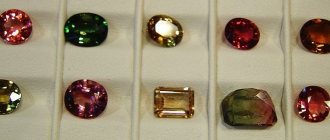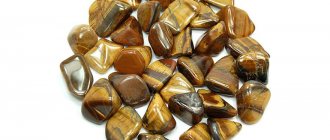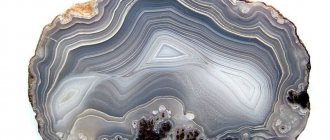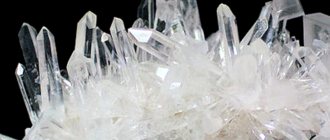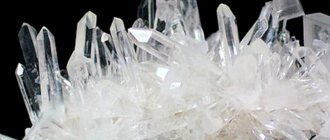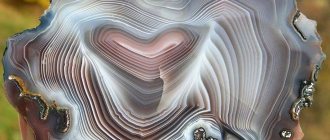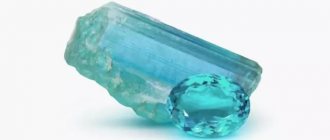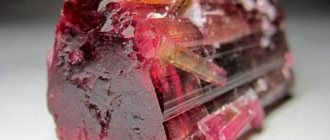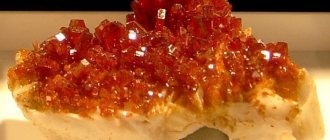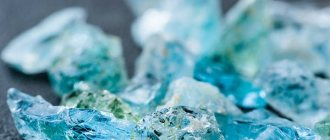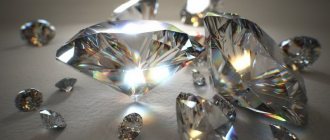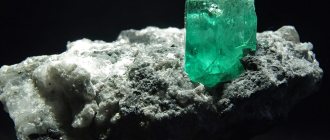Origin of the mineral
Achroite is a colorless or almost colorless form of tourmaline, among all its subspecies it is the most precious due to its rarity. The origin of the mineral is volcanic, formed during the last stage of crystallization of granite magma. Tourmaline is found in pegmatites, granites, metamorphic rocks, skarns and greisen. The name of the stone “tourmali” came from the island of Ceylon along with the gem to Europe.
There are also mystical versions of the origin of the mineral. One of them says that tourmaline was scattered across the Earth by meteor showers. Another legend says that the stone was created by magicians in the Andes mountains.
History of tourmaline
People have known tourmalines for a very long time; these gems were set into gold back in Byzantine times, and then in Rus' they found their deposits, and craftsmen began to actively use this stone.
Later, tourmalines came to Europe, where they were brought by sailors from Ceylon. The aborigines called the mineral “turmali,” which translated as “the one that attracts ash.” This name was due to the fact that the stone became electrified when heated. — Advertising —
Expensive and beautiful tourmalines have always been valued by kings of various countries. They decorated crowns and made rich, exquisite jewelry from them. Today, tourmalines are also very popular in jewelry.
Achroite deposits
Achroite is found in deposits about. Elba (Italy), o. St. Helena, as well as in the USA (California), Brazil, Namibia, Madagascar, Kazakhstan, Tajikistan and Germany. In Russia, the mineral is mined in the Urals and Transbaikalia. In nature, it is found in primary deposits or placers. Achroite is typically found in pegmatite veins or hydrothermal ore deposits. Often accompanied by the presence of other minerals:
- beryl;
- wolframite;
- cassiterite;
- smoky quartz;
- topaz.
Tourmaline colors
For tourmaline, there are about 50 known colors and shades in which it can be painted.
As a rule, each color has its own name and is considered a separate variety. Green tourmaline is considered a classic stone. Crimson and pink tourmalines are also widespread in nature; yellow and blue crystals are rare. Polychrome samples are also found that combine several shades at once. All of them can be either transparent or opaque. Often the color is distributed unevenly over the surface of the stone: its intensity changes from different viewing angles. There are specimens with the “cat’s eye” effect and with alexandrite.
Physical properties, characteristics and chemical composition
Colorless tourmaline has thermoelectric and piezoelectric properties, is capable of weak luminescence, with a weak greenish-blue glow, as well as spontaneous polarization (pyroelectric). The shape of the crystals is elongated prismatic, needle-shaped, granular. The mineral is characterized by the following characteristics:
- Syngony Trigonal
- Trait color White
- Cleavage Absent
- Glitter Glass
- Transparency Transparent
- Fracture Conchoidal, splintered
- Hardness on the Mohs scale 7.5 – 8
- Specific gravity, g/cm3 2.9 – 3.1
The basic chemical formula of the mineral is Na (Mg, Fe, Mn, Li, Al)3 Al6 [Si6O18] (BO3)3 (OH, F)4. The composition varies depending on the subtype of tourmaline. Achroite is richest in Al2O3 and Li.
Industries of use of tourmaline
Large tourmaline crystals are used in radio engineering.
Their piezoelectric properties are used as a source of negative ions for medical devices (health mattresses, pillows, lumbar belts, knee pads for improving the musculoskeletal system). According to the color characteristics and degree of transparency, various types of tourmalines are classified as either precious or ornamental stones. The most valuable are transparent samples painted in green, blue and crimson-red, as well as polychrome green-reddish ones. They are widely used in jewelry as inserts in a wide variety of jewelry: rings, pendants, earrings, brooches, etc.
Magical and healing properties of tourmaline. What zodiac signs is it suitable for?
Due to the fact that achroite crystals are capable of emitting infrared rays, it is used in medicine. This property helps accelerate metabolism, dilate capillaries, and activate body cells. Saturates the surrounding air with oxygen ions and removes dust. Traditional medicine claims that the mineral has a positive effect on the endocrine system and improves immunity.
The mineral is also credited with magical properties. It is believed that it is able to protect against negativity and brings good luck and happiness. Colorless tourmaline helps to reveal creativity, activate brain activity, and increase attention. Under the influence of this gem, a person’s physical and moral endurance increases. Therefore, it is recommended to wear jewelry made from this stone (beads or rings) during periods of life when you need to show perseverance and courage. It can also relieve depression and relieve insomnia. Achroite is most suitable for Leos, Scorpios, Sagittarius and Capricorns. But this mineral is not tied to any specific planet, so it will also be an assistant to other zodiac signs.
Artificial tourmaline
Natural tourmalines are refined by heating to temperatures of 450-650°C, with brown-red stones turning pink, and dark green ones becoming emerald. Today, technologies for producing synthetic tourmalines have also been developed, but the cost of such stones is very expensive, and therefore their production does not make sense yet due to the sufficient abundance of natural minerals.
Types of fakes. How to distinguish natural stone?
Due to its rarity, achroite is one of the most expensive precious minerals, so counterfeiting of this stone is a common occurrence. There are several types of fakes of almost colorless tourmaline: A natural stone similar to tourmaline. Any mineral similar in color, shape and strength.
- Glass. Due to its high level of transparency, it is often found in fakes.
- Plastic. The lowest quality and cheapest fake. Occurs when selling jewelry or stone.
- Synthetic mineral. This sample is quite rare, because... its production is quite expensive. It can only be distinguished from the real thing in the laboratory.
There is a risk in buying counterfeit achroite from private individuals who work through intermediaries and do not have direct contacts with the deposit. And also when ordering stones from another country with delivery. When purchasing, you should pay attention to the size; large samples are rarely found on the open market. Also suspicious would be an excess of all types of tourmaline from one seller and a low price. Another fact of counterfeiting is the presence of inclusions; the natural mineral has almost no impurities.
Video on the topic: Tourmaline gemstone. All types of tourmaline
The most important distinguishing feature of tourmaline is its ability to electrify. To do this, heat the mineral by holding it in your hands or rubbing it, after which it will attract small pieces of paper or cigarette ash. You can try to scratch the achroite; natural stone, having high hardness, will not be damaged. These are the most effective ways to distinguish natural tourmaline from a fake. But there are good artificial specimens that can be distinguished only in laboratory conditions. Therefore, when purchasing, you need to require from sellers a certificate of purchase from the fields, as well as find out information about suppliers in advance and read reviews about them.
Types of tourmaline
— Advertising —
The properties and color of tourmalines are determined by the chemical composition of the stone and are very diverse. There are more than 500 species of this gem in the world. Some of them:
- Black tourmalines or schorl contain large amounts of iron.
- Green tourmalines or verdelites. They contain chromium and iron compounds as impurities.
- Dravites are a magnesium-containing variety, which is characterized by several shades. The main color is yellow. In addition, there are specimens colored brown and brown.
- Indigolites are painted in an exquisite blue color. They are rare in nature and very valuable. The blue tint appears due to the content of iron compounds.
- Achroites are colorless tourmalines.
- Watermelon tourmalines are rare polychrome stones that are so named because they resemble a piece of watermelon. Red and green inclusions are expressed on the white background of the stone, which looks very beautiful in jewelry.
- Paraiba tourmaline is the most beautiful and pure subspecies, which is characterized by a unique neon glow in blue tones. The stone deposits are located in Brazil. It is often confused with sapphires.
- Rubellites are colored in shades of pink and red (crimson, red, violet and light pink).
In addition to these main varieties of tourmaline, many more of its subspecies are known. Thus, cherry-red stones that are mined in Siberia are called Siberites. Burmese tourmaline is characterized by reflections of garnet and dark red shades.
Tourmaline - contraindications and harm
Although tourmaline has healing properties, there are contraindications to its use. Tourmaline stone with its healing properties should not be used on the first day after injury, when body temperature is high. Jewelry with this stone should not be worn by people with a pacemaker, as tourmaline's electrical field interferes with its function.
Not recommended for allergy sufferers and people with thyroid diseases. It is unknown what effect the electric field has on the body of an unborn child, so pregnant and breastfeeding women are not recommended to wear this gem.
How to care for tourmaline
Treated tourmalines are very hard, durable and stable stones and do not require special care. To clean jewelry with them, a warm soapy solution and a soft cloth are suitable; the procedure is repeated once every 2-3 months. Steam and ultrasonic treatment are not used.
Schorl
The most popular type of tourmaline is Sherl (about 95% of all tourmaline). Opaque black schorl is an idiochromatic type of tourmaline (it has a high iron and manganese content), unlike other forms, it is not transparent. Externally, it consists of elongated prismatic crystals of a layered structure or short strong prismatic crystals.
Combination with other stones
Tourmaline belongs to the element of Air. It goes well with stones from its own group: sapphire, rock crystal, quartz.
Compatibility with minerals of the Earth element is neutral. They will not conflict. This includes:
- agate;
- nephritis;
- chalcedony;
- hematite.
It is dangerous to combine with fiery minerals. The elements of Air and Fire reinforce each other; it is very difficult to cope with such energy. You can combine tourmaline and ruby, diamond or garnet only for a short period of time (a few hours).
It does not combine with moonstone, opal, aquamarine, pearls, that is, the water element.
Prices for tourmaline products
The average cost of tourmaline is about $40 per 1 carat.
But, for example, Paraiba is valued at much more expensive - $6,000 per carat, some of the rare Russian varieties reach $10,000 per carat. The higher the transparency and purity of the crystal, the more expensive it is. Recently, prices for tourmaline have increased significantly - about 70 times.
